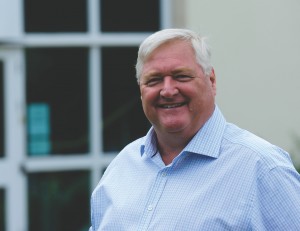SVG Europe Sit-Down: Media Links’ John Smith on IP migration and the future of broadcast technology
Media Links was founded upon a vision of developing innovative technology to enable and enhance viewer experience throughout a connected world of video. To accomplish this goal, it has developed ground-breaking technology that allows the movement of all types of media content across IP networks. As John Smith, Managing Director of Media Links EMEA emphasises, IP is certainly the way forward…
When a broadcaster is thinking of moving to an IP facility, what are the key factors to consider?
Moving to incorporate IP into broadcast infrastructures is inevitable! However, timing is critical. Broadcasters need to consider when is best to move from a business perspective. The benefits, short medium and long term need to be considered carefully: will the move ultimately save money? Will it help make money?
Interoperability and uncertainty about which vendors are best placed to help organisations achieve their IP media networking and content delivery goals is a major issue and the key reason why broadcasters have been hesitant. However, there are other factors to consider in the migration to an IP facility, including workflow, flexibility, growth, and budget.
Workflow includes eliminating conversions from/to SDI by bringing IP content directly into facilities. Many broadcasters are telling us that they have built their last SDI facility, the days of baseband routers are over. To gain flexibility, they’re now using IP for ingress/egress transport and central core switching.
A strong driving force towards IP in the industry has been remote production. We see leading US broadcasters already pushing the envelope to achieve ambitious cost reduction goals. Some are gaining IP experience by first using the technology for lower league sporting events. We carried a lot of remote production traffic during Rio last summer. One successful customer strategy was to first build IP “islands” for specific events and then later add trunks to interconnect these islands.
Specifically, what about packet processing?
We enable hitless protection for any of the signals transported as two identical output streams are routed over separate paths to a single destination. Errors on one stream are avoided by immediately switching to the other buffered stream, preventing packet loss. This model has been used to provide live content contribution for the Sochi Winter games and World Cup soccer, experiencing 100% uptime and we are now adding hitless data, as data is becoming increasing important for the production process.
What do you see as the major challenge facing your company when it comes to sports broadcasting demands?
The biggest challenge for all suppliers is understanding the business benefits from the client’s side. Technology makes many possibilities, but there must be a way to make it pay! Understanding how content can be monetised is key and it’s changing as the technology opens up more opportunities.
As a result, clients need flexibility from a technical perspective to re-purpose content on the fly for example. However, they also need flexibility from suppliers, paying only when they need services, with the option to scale quickly, with a guarantee of interoperability.
Here we are back to the challenge of interoperability. Competing IP standards from AIMS, SMPTE, and ASPEN have created uncertainty in the industry which, in turn, has slowed IP infrastructure adoption rates and spending. Few customers will spend money on proprietary solutions, they need assurances that equipment will work with standards or can be upgraded to be standards compliant.
With SDI, the workflows have been consistent, all broadcasters cover games in essentially the same way. With IP, however, new workflow paradigms are still evolving, for example, are you using IP end-to-end or converting between SDI and IP in different parts of the network? Are you doing full remote production or following a blended model?
Historically, bandwidth in and out of the venue has been a limiting factor. Although new gigabit Ethernet services have helped in some regions, gaps still remain and need to be filled. When it comes to OTT services at games – think 70,000 mobile phones running a stadium app – this will compound the bandwidth issue.
What advances will we see in OTT services over the next one to two years?
Most of Media Links’ work is in contribution, not in the OTT distribution side. However, we anticipate the industry will eventually move to virtual services with the need to utilise hardware locally.
The broadcasting world is ever evolving. So, what can you do to help a client plan for the diversity of formats such as UHD, HDR and OTT?
Media Links introduced support for 4K back in 2015. Our equipment uses J2K and H.264 compliant codecs; HEVC is in the works. As a standards-based company, we like to maintain our neutrality. Through our strong engineering engagement in organisations like SMPTE and the VSF, we help when there is a lack of standards and make interoperability easier when standards become a reality. This makes solutions simpler and less expensive for our customers. The main point is that we talk to and understand our client base and avoid making assumptions about what they need and why.
Prediction time. How do you see the move to IP playing out in the immediate and medium term?

The MD8000 series is Media Links’ flagship solution for transporting 4K, 3G/HD/SD-SDI, and DVB-ASI over IP networks
The IP world is not new, for some industries it’s an everyday piece of technology that is not even considered as it’s the norm! For others, its seen as a black art. I believe we need to get away from the two letters “IP” Internet Protocol and consider the business and social implications changes in technology can bring.
From a technology perspective, the answer is usually yes, depending on budgets. Timescales are increasing important. The real question is, what can the technology do for me and when?
As a result, when it comes to near-term IP migration strategies, we are seeing remote production as the low-hanging fruit for many of our customers. This is because return on investment can be particularly rapid. There are immediate cost savings to be achieved on shipping equipment – you can leave the OB truck at home! and the chance to cover more live events opens up new and exciting revenue streams. We see the pace of adoption for remote production type services continuing to increase for the next three years.
On the other hand, in studio IP adoption standards are evolving more slowly because it is less obvious to realise the increased revenue connection. We anticipate in-studio IP may reach fruition around 2020.
We’re also starting to see more interest in discrete elementary flows for video, audio, and metadata.
Back to today. Do you have any sports related case studies you can share?
Since 1993, Media Links’ equipment has been used in many high-profile sporting events throughout the world, including Olympic Games, multiple World Cup tournaments, the Big Game, Confederations Cup, X-Games, and many more.
This year Media Links’ technology was used to help win viewers for winter sports competition coverage in Germany. Media Links’ partner and German based distributor VIDI provided Media Links’ MD8000 IP transport solution, to supply coverage of ski jumping, alpine skiing and biathlon from various remote locations for live transmission by the German public broadcasters ARD and ZDF.


